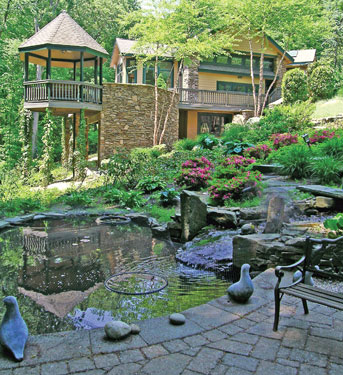
 by Jennifer Jones
by Jennifer Jones
A gazebo is typically considered to be an open structure with a solid roof. It has many uses including a rain or shade shelter, a place for solitude and reflection, or just as a decorative component in a landscape. The key feature of a gazebo is to be strategically situated to offer beautiful views of the surrounding area. It is often seen as a place of refuge within a garden. Although remote from the primary dwelling, it often is a smaller reflection of the main home. In early times, these buildings were erected for the purpose of religion, pleasure and attractiveness.
View This House Plan to the left
View Other Luxury House Plans
For thousands of years, the functionality of gazebos has evolved from religious monuments to modern day entertainment fixtures. Originally known as grottos, arbors, pergolas, screen houses and summerhouses, many different societies have embraced the beauty of a gazebo. With every new generation, their popularity as the most prevalent outdoor garden structure becomes more widespread and innovative.
Originating as towers, gazebos were built on the roofs of houses to provide advantageous views or the surrounding lands. They eventually made their way to the ground level as functional garden structures. Five thousand years ago, Egyptians built them in gardens as a paradise on Earth and often depicted them on the murals in tombs. The wealthy Egyptians would plant gardens with trees, flowers and crops near a body of water. The gazebos would provide shade during festivals and also act as a support for vines that produce wine and raisins. They believed that the gazebos and the palace gardens would follow them on the journey heaven when the royalty member died. The prominence of the gazebo soon spread to the common people and the structures were built in just about every garden.
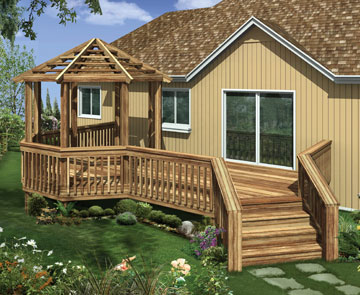
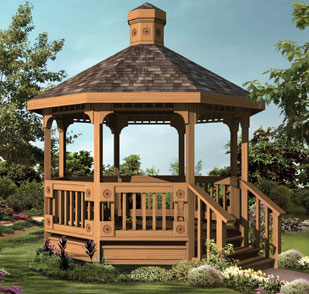
View Gazebo Plan on the left above
View Gazebo Plan on the right above
View Other Gazebo Plans
While some gazebos were used as tombs, most of them were built as garden structures. Tenth-century Persian gardens produced a wide variety of the gazebos. They ranged from colorful tents with mats on the floors, to ornate structures with marble columns, cupolas and golden seats. Since pools and fountains were a major feature of Persian gardens, some gazebos were constructed across the cold running water features that helped cool the marble floors. A wealthy Persian could escape from the heat and make his way to a gazebo situated in his own bit of paradise surrounded with lush plants. In addition to serving as an aesthetically relaxing paradise, the garden gazebos were also areas where politics and business took place, diplomats greeted and treaties signed.

View This House Plan to the left
Gazebos began to flourish across the East, with many ancient remains discovered in Rome and Pompeii. Archaeological ruins in Pompeii have discovered that almost all citizens had a private garden used to grow flowers, fruit and vegetables. These private gardens served as a place of relaxation to escape from the fast pace of urban Roman life. On the other hand, Greeks were unlike the other cultures in that they did not own private gardens. Instead, all their gardens were public spaces and built around temples. Gazebos were constructed out of marble in a smaller design of the main temple. Since the gazebo and the garden were regarded as the same space as the temple, they were often dedicated to a particular god or goddess and considered sacred. It was at this time when gazebos became not just the domain of the wealthy and were being built in every garden.
In China, gazebos continued on the religious tradition of the Greeks. However, instead of marble, they were originally constructed of wood that made them resistant to earthquakes. Chinese art and iconography were painted on the gazebos in gold, red and black Oriental colors. They became much more elaborate and were used as places of meditation, worship and prayer. Zen Buddhists began to create innovative, beautiful rock gardens and gazebos at their Zen temples of meditation.
By the 4th century, a gardening culture that developed in China broke off and travelled across the sea to Japan. Gazebos, often called teahouses in Japan, were regarded as places to relax. They would hold religious tea ceremonies to get in touch with one’s spiritual side. The space was perfect for relaxing, personal spiritual meditation and enjoying the beauty of the garden. The Japanese’s view of a gazebo paved the way for the culture of Western world gazebos, designed to be a structure of peace and reflection.
It was during the Renaissance that gazebo construction began to expand in Europe. During the 14th century, four gazebos, constructed at the Louvre, influenced the English to include these beautifully designed structures in their gardens. Monks began to use them as a place of meditation and prayer in the gardens of monasteries. In the 15th century, they became entertaining structures in Elizabethan gardens and were modeled after the design of the main house. By the 1700’s, these summerhouses were in gardens all over England and other parts of Europe.
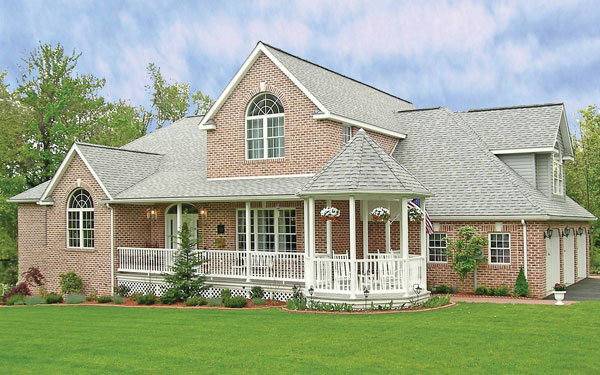
View This House Plan
View Other Traditional House Plans
As gazebos became incredibly common in Western Europe, they did not gain favor in the United States until the mid-1800s. The prosperity of a wealthy middle-class brought about the beginnings of gazebo construction in the New World. They made a huge jump in popularity in the 1930s, as homes were being built with expansive porches. They became a sort of status symbol for the rich and famous. Unfortunately in the 1940s, gazebos took a backseat to the construction of patios, however in the 1980s, they once again surged as people recognized the advantage of having a quiet place to retreat to from the household chaos.

View This House Plan
View Other Craftsman House Plans
In today’s time, gazebos are still popular as an outside room. Traditional gazebos were open structures, however, modern day styles do not necessarily follow these earlier designs. Architects began to explore new ideas on a smaller scale to create the structures. The gazebos became modest in size and rather inexpensive, so the design could produce much novelty. They come in a variety of shapes and are being built in homes and gardens all across America. Gazebos can be built connected to the house with a deck or as a garden focal point, near a pool or a pond. They are effective just about anywhere on the landscape for providing a lovely place to enjoy the beautiful surroundings. With the proper planning, a gazebo can be successfully constructed to the expectations and desired function of the homeowner. Here are some key aspects to consider when planning a gazebo:
1. Functionality - The first step to consider when building a gazebo is what will be its primary use of activities. Some people decide to build a gazebo for a future wedding or family gathering. If it is to be used as a place to entertain guests, then the size should be large enough for a table and chairs. A smaller gazebo would be ideal for a small amount of people with the additions of simple furnishings. The ideal large gazebo is one fifth of the total area of the yard and the minimum for a small gazebo should be no less than 6 x 6 feet. Additionally, many people use the functionality of a gazebo to house a hot tub. A warming soak can rejuvenate the body and mind in the relaxing shelter built around it. Be sure to include access to a water line if it will be housing a hot tub or wet bar.
2. Location - The next step is to specify the ideal location for the gazebo. Many homeowners choose a location in front or beside the house. This position is ideal for friends and family to have convenient access to the home for a quick trip to the bathroom or kitchen for a snack. Another common location is in the middle of a garden to act as a focal point to enjoy the surroundings. A corner of the yard or garden location definitely provides the ambience of a quiet retreat from everyday stresses. Also, proper access to the gazebo is of high importance, so it’s a good choice to develop a clear pathway to easily access the structure. A stone pathway is perfect to provide a comfortable walkway and give a natural impression.
3. Design - Now its time to determine what type of model to build. Gazebo selection often depends on a design that fits the home and garden view. Depending on the homeowner’s personal preferences, they can be round, square, octagonal or rectangular. They can also choose from a wide range of styles, including small, large, ornate, plain, elegant, or rustic. Each one has some unique look and quality to complement the different decor and theme of the home. If the location is in front of the house, it is a good idea to choose materials and a style that compliments the exterior design of the home. The material selection should be weather resistant and durable to ensure an ever-lasting gazebo.
4. Accessorize - The final step is to beautify the gazebo. Some include shutters around the building for privacy or warmth. Built-in benches, a hammock chair, wicker tables, a loveseat, or a small fire pit all make perfect additions to the interior of a gazebo. Some pillows on the edge gazebo will be a comfortable backrest for relaxing. Curtains or screens are efficient for keeping bugs and dust out. They also can provide additional shade from the sun and add more color and beauty to the structure. For nighttime enjoyment, lighting can be installed to further enhance the gazebo. It should not be too bright, but light enough to provide illumination for activities.
Building a gazebo will not only enhance the luxury aspect of your home, it will provide a safe haven from the worries of everyday life. Like times before, a gazebo still remains a place in the garden that enhances the landscape and allows for enjoyment of surrounding beauty. Being the perfect quiet place to retreat away from telephones, computers and other electronic devices, a gazebo has become a getaway right in your own backyard.
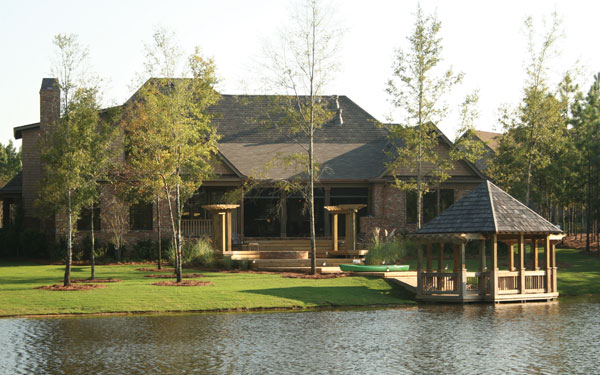
View This House Plan
Here are some related articles:
Save this article to:
back to top